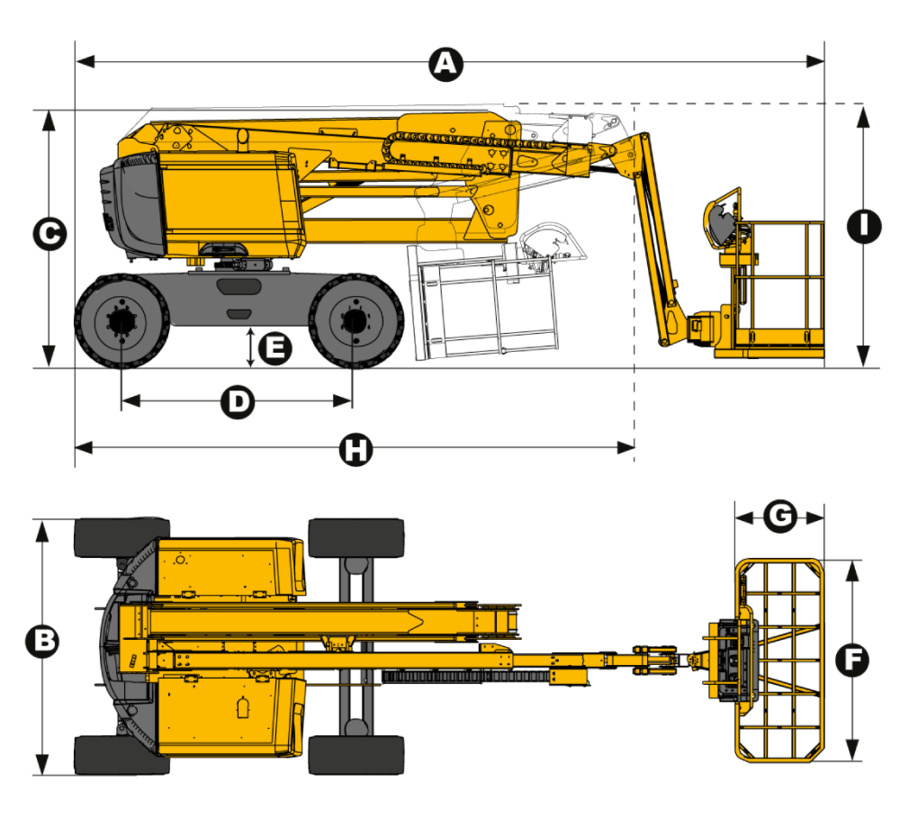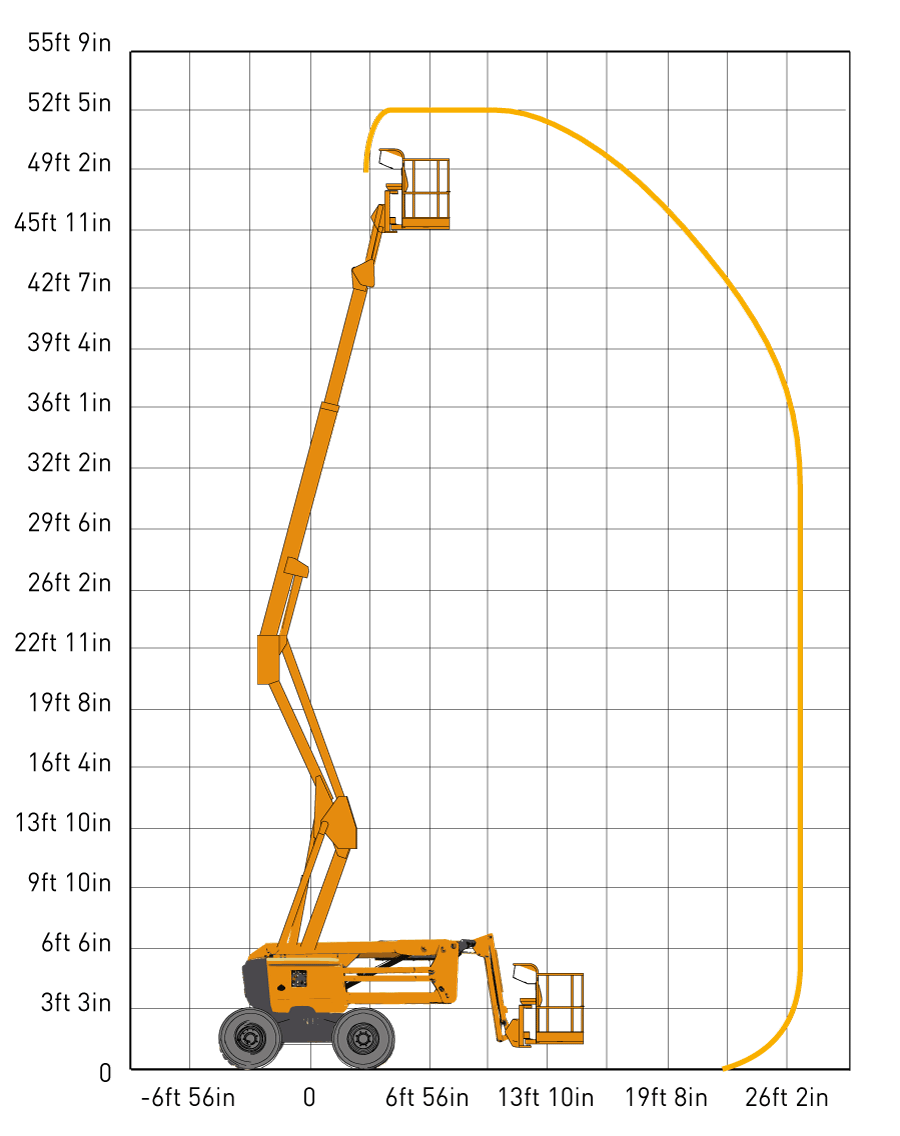- Monday 7:00AM - 5:30PM
- Tuesday 7:00AM - 5:30PM
- Wednesday 7:00AM - 5:30PM
- Thursday 7:00AM - 5:30PM
- Friday 7:00AM - 5:30PM
- Saturday Closed
- Sunday Closed

MANLIFT - 45' Articulating Boom - 4 wheel Drive ( DIESEL )
Equipment Specs
Height (In) 91 Width (In) 91 Length (In) 266
Max. Working height (ft) 52
Horizontal Reach (ft) 27.3
Weight (lbs) 14663 Capacity (lbs) 500
| Working height | 51 ft 11 in |
| Platform height | 45 ft 11 in |
| Horizontal outreach | 27 ft 3 in |
| Up and over clearance | 25 ft 1 in |
| Lift capacity | 500 lb (2 pers.) |
| Platform size | 95 in x 34.5 in |
| Length | 22 ft 2 in |
| Width | 7 ft 7 in |
| Height - stowed | 7 ft 7 in |
| Storage / transport length | 16 ft 7 in |
| Storage / transport height | 7 ft 10 in |
| Vertical jib rotation | 140° (- 80° / + 60°) |
| Platform rotation | 165° (- 75° / + 90°) |
| Turntable rotation | 360° continuous |
| Tailswing | 4 in |
| Wheelbase | 6 ft 11 in |
| Ground clearance | 15 in |
| Tilt | 5 ° |
| Drive speed | 3.2 mph |
| Maximum wind speed rating | 28 mph |
| Gradeability | 40 % |
| Tires - solid rough terrain | 32.7 x 11.2 in |
| Turning radius - outside | 12 ft 4 in |
| Power source | Kohler, TIER 4 final : Stage V, KSD 1403 NA / 18,4 kW |
| Weight | 14,420 lb |
| Ground clearance - mini | 0 ft |
| Ground clearance - maxi | 0 ft |


Both articulated and straight boom lifts can tackle tough jobs and come in a range of options:
- Indoor and outdoor
- Engine- (diesel, gas, LP), electric- or hybrid-powered
- Tracks versus tires
- High-capacity versions
Each have their own unique attributes that make them better suited for different types of work. For example, a JLG® telescopic boom lets you reach farther, with more capacity, which puts you right where you need to be as simply and efficiently as possible. While JLG articulating boom lifts are ideal for jobs that require you to get “up and over” objects.
So, how do you know which type of boom lift is right for your job site? Here is more information to help you make the choice between articulated and straight…
Articulating booms
The most easily recognizable type boom lift is articulated due to the boom’s distinctive shape. This type of lift uses multiple pivot points (referred to as joints or knuckles) on the boom sections to give you length and reach, allowing you up-and-over access, as well as vertical reach. The main advantage of this design is that it lets you achieve difficult positioning around obstacles at height.
Articulating boom lifts have less horizontal outreach than telescopic booms, but because they can reach high and far, these machines provide greater versatility to:
- Work in space-restricted, tight or narrow access and/or confined work areas
- Reach up, over and/or out to access work areas
Telescoping booms
The mast on a telescopic boom lift extends out in a straight line, by utilizing one or more telescoping boom sections, to give you enough vertical reach to directly access overhead job sites. This design allows you to take full advantage of the boom’s entire range of horizontal reach.
Because of their design, telescoping models do not offer up-and-over ability to access work at height. And, this type of boom lift requires more space to operate within than articulating booms, including plenty of room around the machine’s chassis to make turns and other movements.
But straight boom lifts can typically reach higher than articulating boom lifts, which means these models provide both maximum height and maximum outreach to:
- Access work from a distance, especially where the terrain or obstacles prevent close access
- Get into working position quickly
Tips for choosing one versus the other
It’s important to understand the specific work-at-height requirements on a particular project before you specify the machines to do the work.
Here are three things to consider when choosing the right boom lift to match your application:
1. Agility versus versatility
a. An articulating boom would be the preferred choice for applications that require agility to reach over or around objects, such as chimneys, ceiling joists or roof trusses, HVAC or electrical fixtures, the floors of a building under construction or warehouse shelves
b. A telescopic boom lift would be the best choice for applications that require the versatility to reach high, like multi-story buildings, or to reach far out at a lower level, like under bridges.
2. Job site conditions
a. An articulating boom lift generally offers you a more compact footprint and narrow operating profile, especially zero tail swing models, ideal for space-restricted job sites.
b. A telescopic model is more productive on job sites with plenty of room to turn and space to reach.
3. Outreach
a. An articulated model can offer you multiple angles and reach to access overhead work.
b. A telescoping boom lift often can reach higher than an articulating boom lift (depending on specific model and design differences).
The best way to distinguish between these two types is this: Telescopic models are better for getting people and materials into place and holding them there, and articulating versions are better suited for moving people and materials around obstacles and into different positions with agility.










